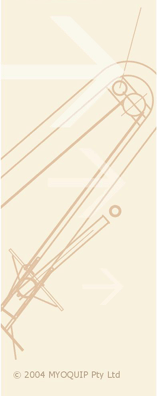Squat
"A biomechanical model for estimating moments of force at hip and knee joints in the barbell squat" Bruce Ross
"It ... seems appropriate to question the efficacy of the squat as a general exercise for developing leg strength. In particular the wisdom of its use in preparing athletes for participation in sports that themselves have high incidence of back and knee injury must be doubted."
www.myoquip.com.au
"Biomechanics of the knee during the squat exercise"
"The purpose of this paper is to review the effect of squatting in a weight training program. Such issues as co-contraction within the thigh muscles, open verses closed kinetic chain exercises, torque at the knee and proper form will be discussed."
Steeves Training Systems
"Biomechanics research: the squat, bench press, and deadlift" David J Sandler
Powerpoint presentation of relevant literature
StrengthPro.com
"Exercise: barbell squat"
"In the up phase of a squat the hip joint is extended by the concentric contraction of the gluteus maximus, semimembranosus, semitendinosus and the biceps femoris. The knee joint is extended by the concentric contraction of the rectus femoris, vastus medialis, vastus intermedius and the vastus lateralis. The ankle joint is plantar flexed by the concentric contraction of the gastrocnemius, soleus, tibialis posterior, flexor hallucis longus, flexor digitorum, peroneus longus and the peroneus brevis."
Fitness Institute Australia
"Squat analysis"
"Torque force is necessary for the muscles and joint structures to adapt to the respected overload. If the knee does not travel forward during the barbell squat, the quadriceps muscles are not significantly exercised. On the other hand, injury may result if the knee or lower back experience greater torque forces than to what they are accustomed."
ExRx.net
"Squat exercise - should you prescribe the squat as a rehabilitation exercise? Here's a review of the evidence"
"very deep squats involve high compression forces making them unsuitable for patients suffering with knee injuries.
"
Sports Injury Bulletin
"Squat research review"
"if you want to be able to jump high or leap long in your sporting activity, you would be wise to focus very heavily on squat training, since it correlates very, very well with both these attributes."
Peak Performance
"Squatting and the implications of technique on muscle function" David Woodhouse
"Increased lifting speed causes higher maximum, and greater variation in, shear and compressive force in the knee and spine. This is because a faster descent requires greater deceleration forces from the knee and hip extensors in order to slow and stop the weight at the bottom of the descent ."
Dr. Squat
"Squatting exercises: How safe is squatting? Does it injure the knees or even the spine? Here's an exhaustive review of the research" Owen Anderson
"when individuals hurt themselves while squatting, it may not be the exercise itself which is harmful - but the manner in which the squatting is performed."
Peak Performance
"Squatting exercises: How safe is squatting? Does it injure the knees or even the spine? Here's an exhaustive review of the research - Part 2" Owen Anderson
"Although incorrect utilization of the squat exercise during training can certainly heighten one's chances of getting hurt, correctly performed squats are not only safe, they also can dramatically improve functional leg-muscle strength, jumping ability, and running speed. "
Peak Performance
"The role of synchronised hip and knee joint angles in efficient squatting " Bruce Ross
"I suspect that many people fall into the habit of excessive forward trunk lean from observing power lifters. However a typical power lifter is probably someone with a very strong back who is focussed on muscling up maximum weight without being concerned as to whether they are adequately exercising their leg extensors."
MyoQuip Blog
| 

